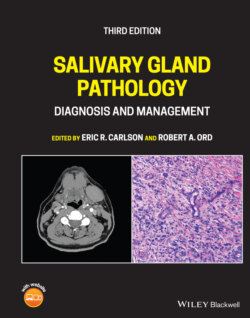Читать книгу Salivary Gland Pathology - Группа авторов - Страница 120
Treatment of Acute Bacterial Parotitis
ОглавлениеThe treatment of ABP is a function of the setting in which ABP is diagnosed, as well as the severity of the disease within the parotid gland and the presence of medical comorbidities (Figure 3.8). In the outpatient setting, the presence or absence of pus will assist in directing specific therapy. The presence of pus should result in culture and sensitivity. Early species‐specific antibiotic therapy is the sine qua non of treatment of ABP. Empiric antibiotic therapy should be based on a Gram stain of ductal exudates. In general terms, an anti‐staphylococcal penicillin or a first‐generation cephalosporin is a proper choice. Antibiotics should be changed if cultures and sensitivities show methicillin‐resistant staphylococcal species, in which case clindamycin is indicated in community acquired ABP. In the absence of pus, empiric antibiotic therapy should be instituted as described above. Antibiotic compliance is often difficult for patients such that once or twice daily antibiotics are always preferable. In all patients with community acquired ABP, other general measures should be followed including the stimulation of salivary flow with digital massage, the use of dry heat, and the use of sour ball candies. Sugarless sour ball candies should be recommended for diabetics or those with impaired glucose tolerance. Some elderly and debilitated outpatients may require admission to the hospital in which case intravenous antibiotic therapy will be instituted and incision and drainage may be required. Alteration of anti‐sialogogue medications should be accomplished as soon as possible. In the outpatient setting, these commonly include urinary incontinence medications, loop diuretics, beta blockers, and antihistamines. Glycemic control in diabetics is beneficial in the control of ABP. Finally, effective control of viral load in HIV‐infected patients is of utmost importance.
Figure 3.7. Axial (a) and coronal (b) CT scans of a patient with a hospital acquired parotitis. The degree of swelling led to the acquisition of these scans to rule out intraparotid abscess. No abscess was identified, thereby not requiring incision and drainage in this patient.
Figure 3.8. The algorithm for diagnosis and treatment of a unilateral or bilateral parotid swelling.
Imaging of outpatients with community acquired ABP is based on the severity of the clinical disease, its chronicity, and the clinician's suspicion for intraparotid abscess. Obtaining routine plain films, such as a panoramic radiograph, is certainly indicated to investigate for the presence of a sialolith. It may be acceptable, however, to defer special imaging studies in these patients until refractory infection develops. Patients with severe symptoms, fever, and concern for abscess formation within the parotid gland should be imaged with CT scans in an expedient fashion (Figures 3.7 and 3.9). Except in the presence of severe immunosuppression or other medical comorbidity, refractory infections are uncommonly seen in ABP.
The general principles of the management of hospital acquired ABP are identical to those of the community acquired ABP. As previously described, however, the risk factors differ. In these inpatients, rehydration should be performed with caution to avoid cardiac overload. Empiric intravenous antibiotics should be instituted in these patients, and confirmed as to their efficacy with culture and sensitivity of purulent parotid exudates whenever possible. The use of heat to the affected gland is appropriate in this setting, as well. The inpatient should be monitored closely for clinical improvement. Despite the institution of conservative measures, if the patient's course deteriorates within 48–72 hours as evident by increased swelling and pain, or an increase in white blood cell count, an incision and drainage procedure is indicated (Figure 3.9). Such a procedure must be guided by CT scans to explore all loculations of pus. A needle aspiration of a parotid abscess is unlikely to represent a definitive drainage procedure, although it will permit the procurement of a sample of pus prior to instituting antibiotic therapy in preparation for incision and drainage.
